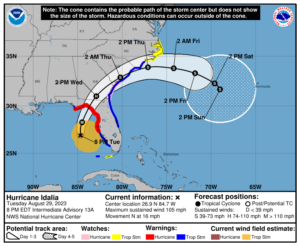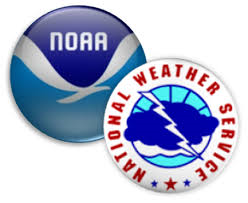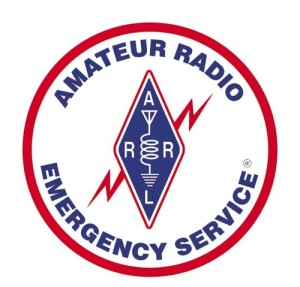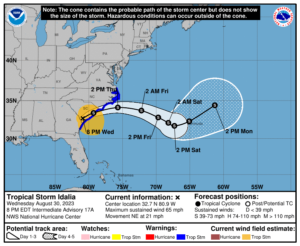HURRICANE IDALIA – 2100 EST – 8/29/23
Hurricane Idalia (pronounced ee-DAL-ya), which was declared a hurricane at 0500 EDT today, is continuing its northward track. Currently Hurricane Idalia is due west of the Port Charlotte area of Charlotte out in the eastern Gulf of Mexico and headed in a northerly direction at about 16 miles per hour. Tropical Storm Idalia is expected to continue to strengthen as it moves north in the southern Gulf of Mexico caught between high pressure to the east and low pressure to the west. Idalia is expected to strengthen into a Category 3 hurricane before making landfall in the big bend area of Florida on Wednesday morning after sunrise, and by Wednesday evening the center of Idalia is forecast to be over southeastern Georgia.
COASTAL WATCHES/WARNINGS AND FORECAST CONE FOR STORM CENTER

SUMMARY OF 2000 EST…0000 UTC…INFORMATION
——————————————————————————-
LOCATION…26.9N 84.7W
ABOUT 155 MI…250 KM WSW OF TAMPA FLORIDA
ABOUT 245 MI…390 KM S OF TALLAHASSEE FLORIDA
MAXIMUM SUSTAINED WINDS…105 MPH…165 KM/H
PRESENT MOVEMENT…N OR 10 DEGREES AT 16 MPH…26 KM/H
MINIMUM CENTRAL PRESSURE…965 MB…28.50 INCHES
SUMMARY OF WATCHES AND WARNINGS IN EFFECT:
A Tornado Watch effective until 0600 EDT tomorrow for the following counties in Florida…
*ALACHUA, CHARLOTTE, CITRUS, DESOTO, DIXIE, GILCHRIST, HARDEE, HERNANDO, HIGHLANDS, HILLSBOROUGH, LAFAYETTE, LAKE, LEE, LEVY, MANATEE, MARION, PASCO, PINELLAS, POLK, SARASOTA, SUMTER, and TAYLOR.
A Storm Surge Warning is in effect for…
* Englewood northward to Indian Pass, including Tampa Bay
A Hurricane Warning is in effect for…
* Middle of Longboat Key northward to Indian Pass, including Tampa Bay
A Tropical Storm Warning is in effect for…
* Dry Tortugas Florida
* Chokoloskee northward to the Middle of Longboat Key
* West of Indian Pass to Mexico Beach
* Sebastian Inlet Florida to Surf City North Carolina
A Storm Surge Watch is in effect for…
* Bonita Beach northward to Englewood, including Charlotte Harbour
* Mouth of the St. Mary’s River to South Santee River South Carolina
* Beaufort Inlet to Drum Inlet North Carolina
* Neuse and Pamlico Rivers North Carolina
A Hurricane Watch is in effect for…
* Mouth of the St. Mary’s River to Edisto Beach South Carolina
A Tropical Storm Watch is in effect for…
* Lower Florida Keys west of the west end of the Seven Mile Bridge
* North of Surf City North Carolina to the North Carolina/Virginia
border
* Pamlico and Albemarle Sounds
A Hurricane Warning means that hurricane conditions are expected somewhere within the warning area. Preparations to protect life and property should be rushed to completion.
A Storm Surge Warning means there is a danger of life-threatening inundation, from rising water moving inland from the coastline, during the next 36 hours in the indicated locations. For a depiction of areas at risk, please see the National Weather Service Storm Surge Watch/Warning Graphic, available at https://hurricanes.gov. This is a life-threatening situation. Persons located within these areas should take all necessary actions to protect life and property from rising water and the potential for other dangerous conditions. Promptly follow evacuation and other instructions from local officials.
A Tropical Storm Warning means that tropical storm conditions are expected somewhere within the warning area.
A Storm Surge Watch means there is a possibility of life-threatening inundation, from rising water moving inland from the coastline, in the indicated locations during the next 48 hours. For a depiction of areas at risk, please see the National Weather Service Storm Surge Watch/Warning Graphic, available at https://hurricanes.gov.
A Hurricane Watch means that hurricane conditions are possible within the watch area.
A Tropical Storm Watch means that tropical storm conditions are possible within the watch area, generally within 48 hours.
FORECAST DISCUSSION:
The following excerpt is from the Forecast Discussion issued at 1700 EDT today:
“The first stages of an eye have been taking shape in visible satellite imagery. The hurricane has a relatively small Central Dense Overcast and a prominent band of deep convection extending over the eastern semicircle, reaching across the Florida peninsula
southward across western Cuba. An Air Force Reserve Hurricane Hunter aircraft just measured a peak 700-mb flight-level wind of 91 kt with the pressure falling to 972 mb. The initial intensity is therefore set at 85 kt.
Idalia is moving faster toward the north, or 360/14 kt, between a mid-level trough over the northwestern Gulf of Mexico and a subtropical ridge over the Greater Antilles. Idalia is expected to continue moving northward and turn north-northeastward as it approaches the Big Bend region of Florida during the next 12-24 hours. There is very little spread among the track guidance, and the NHC official forecast has been placed very close to the HCCA and TVCX consensus aids during the first 24 hours. This has resulted in a westward shift of about 20-25 n mi compared to the previous forecast, although it should be stressed that additional shifts to the track will be possible until the center reaches land.
After landfall, Idalia is expected to turn toward the northeast and then east, moving near or along the coast of Georgia and the Carolinas in 36-48 hours. Uncertainty in the track forecast is still quite large after 48 hours, with many of the global models turning Idalia southward, while some of the regional hurricane models still show the storm moving out to sea. As a result, the official track forecast continues to show slow motion on days 4 and 5.
The 12-hour intensity forecast shows a 100-kt major hurricane. It is imperative to realize that Idalia is expected to continue strengthening beyond that time, possibly close to the 110 kt shown in the previous forecast, before the center reaches land. Weakening is expected after landfall, but due to the system’s expected fast motion, it is possible that Idalia could maintain hurricane intensity as it moves across southern Georgia and approaches the coasts of Georgia and South Carolina. After Idalia’s center moves offshore over the western Atlantic, strong shear is likely to limit re-intensification, and the official forecast essentially flatlines the intensity on days 2-5.”
SITUATION AND ACTIONS:
As of 1700 EDT, the following warnings are still in effect for the ARRL West Central Florida Section:
- Tropical Storm Warning: Charlotte, Desoto, Hardee, and Polk Counties.
- Hurricane Warning: Pasco, Pinellas, Hillsborough, Manatee, and Sarasota Counties.
- Storm Surge Warning: Coastal portions of Pasco, Pinellas, Hillsborough, Manatee, Sarasota, and Charlotte Counties.
Paul Toth NB9X, Assistant Section Manager, has opened the West Central Florida SKYWARN Net on both the NI4CE Analog and NI4CE NXDN repeater systems. On the NXDN system, the SKWARN Net is active on the new SKYWARN talkgroup of 1299. Paul is continuing to disseminate the National Hurricane Center advisories on both nets. For more information on frequencies and coverages of go to:
Due to the ongoing Regional SKYWARN Net, Sanford Wyatt KM4WXX, Net Manager of the Eagle Net that normally runs daily at 2030 hours, announced the Eagle Net will be cancelled for this evening, Tuesday August 29, and possibly Wednesday August 30, if necessary. The Eagle Net will resume normal operation after Tropical Storm Idalia is no longer a threat.
The following ARES Groups have reported that they are currently activated either partially or fully, as of press time:
- Pasco County ARES.
- Pinellas County ARES/ACS.
- Hillsborough County ARES/RACES
- Manatee County ARES.
- Sarasota County ARES.
- Polk County ARES.
- Desoto County ARES.
- Hardee County ARES.
- Charlotte County FLARES.
All ARES, ACS, and CERT personnel should have completed preparations by now and at this point in time should be in a location that is a secure shelter from Idalia until the storm passes. All ARES, ACS, and CERT personnel are encouraged to continue to check each advisory issued by the National Hurricane Center in Miami on Tropical Depression Ten and the Tropical Weather Outlook issued four times daily by the National Hurricane Center.
LATEST NATIONAL HURRICANE CENTER INFORMATION:
Public Advisories: https://www.nhc.noaa.gov/text/refresh/MIATCPAT2+shtml/072333.shtml?
Forecast Advisory: https://www.nhc.noaa.gov/text/refresh/MIATCMAT2+shtml/072100.shtml?
Forecast Discussion: https://www.nhc.noaa.gov/text/refresh/MIATCDAT2+shtml/072057.shtml?
Latest GOES Satellite Floater Images and Loop: https://www.star.nesdis.noaa.gov/GOES/floater.php?stormid=AL172022#navLink.
CONCLUSION
The next WCF SECTION SPECIAL BULLETIN will be issued tomorrow following the 1700 EDT advisory on Hurricane Idalia, unless conditions warrant a sooner bulletin release.









